Remember when summer meant earning your own pocket money and learning what responsibility felt like? For many of us who grew up in the 50s, 60s, and 70s, teenage employment wasn’t just about the paycheck—it was a rite of passage that taught valuable life skills no classroom could provide. Those first jobs taught us punctuality, customer service, money management, and how to take direction from someone other than our parents. Today’s teens still work, of course, but many of the entry-level positions that shaped our generation have disappeared into the mists of time, replaced by technology or changing social patterns. Let’s take a nostalgic journey back to the teen jobs that helped shape a generation but have largely vanished from today’s employment landscape.
1. Soda Jerk
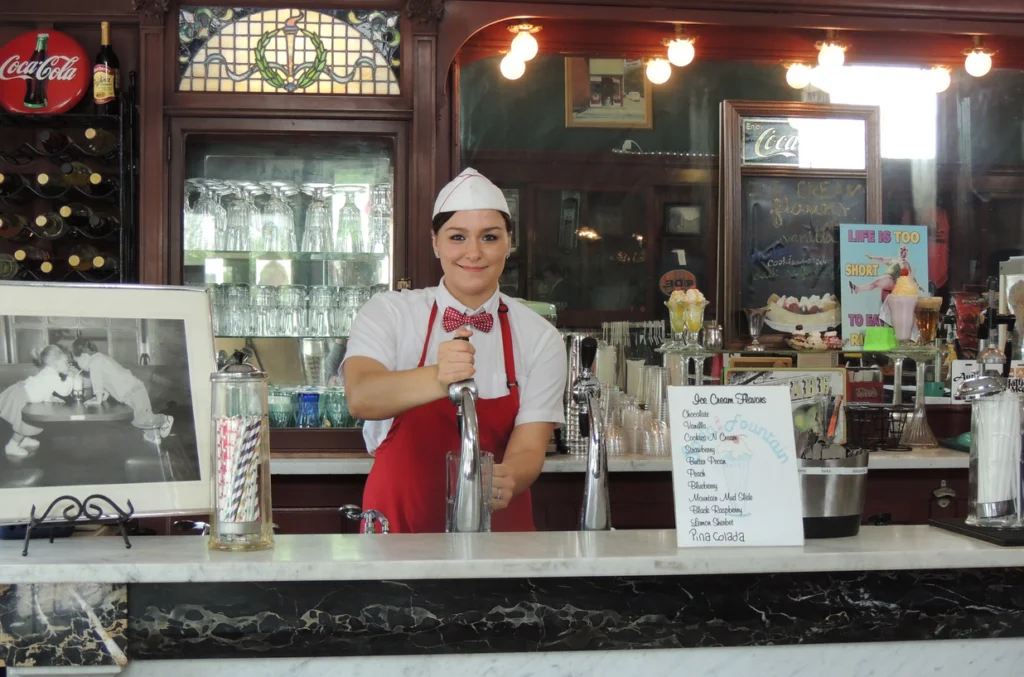
White paper hats, gleaming chrome soda fountains, and the skillful flick of the wrist that created the perfect ice cream float—the soda jerk wasn’t just serving treats, they were performing an art form. These pharmacy and five-and-dime counter workers mixed phosphates, egg creams, and malted milks while becoming neighborhood confidants who knew everyone’s usual order. The position required quick mental math skills, personable customer service, and the ability to work efficiently during rushes while maintaining the cleanliness standards that kept those counters gleaming. Atlas Obscura serves up a sweet history lesson on this obscure job and the lingo associated with it.
What happened? The decline of the local pharmacy and rise of fast food changed America’s refreshment landscape forever. As corporate chain pharmacies replaced neighborhood drugstores and mall food courts offered quicker, standardized options, the soda fountain slowly disappeared from American culture. Today’s teens might make your coffee at Starbucks, but the personalized service and community connection of the soda jerk—along with the dexterity required to hand-mix those special concoctions—has been replaced by automated machines and standardized recipes that require minimal training and offer little room for creative flourish.
2. Paper Route Carrier

Long before dawn, armies of young entrepreneurs were folding newspapers, stuffing them into canvas bags, and delivering the day’s news by bicycle or on foot in neighborhoods across America. The paper route represented a young person’s first independent business—collecting payments, managing complaints, and being responsible for service rain or shine, holiday or school day. This position taught incredible time management and reliability, as subscribers expected their papers at consistent times regardless of weather conditions or personal inconvenience. If this was your first job, Mental Floss has a list of some famous people who also called this their first job as a teen.
What happened? Digital news consumption, centralized adult delivery systems using cars, and changing safety perceptions have eliminated this once-ubiquitous teen opportunity. Today’s newspapers, struggling with declining subscriptions, have consolidated delivery routes and hire adults with vehicles who can cover vast territories quickly. Parents are also less comfortable with children working alone in early morning hours, reflecting our society’s increased safety concerns. While the job taught invaluable lessons about work ethic and personal responsibility, it has been replaced by a world where news arrives instantly on smartphones rather than rolled up on the doorstep.
3. Switchboard Operator
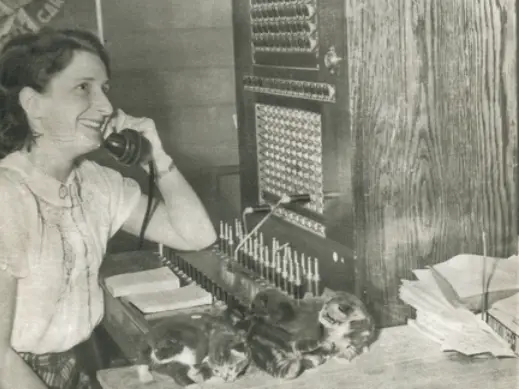
Teens with clear diction and good memories once connected America’s phone calls, managing complex switchboard systems with remarkable efficiency. Young operators, predominantly girls, handled multiple calls simultaneously, connecting lines, transferring calls, and sometimes serving as human directories in an era before automated systems. The position required exceptional focus, a professional telephone manner, and the ability to remain calm under pressure when managing emergency calls or difficult customers. History chronicles the rise and fall of the telephone operator.
What happened? Automated telephone switching technology eliminated the need for human operators, with digital systems handling the once-manual connection process. The skills once valued in switchboard operation—quick thinking, clear communication, and multitasking—have been replaced by algorithms and voice recognition systems. While customer service roles still exist for teens today, the unique technical skill of physically connecting calls on a manual switchboard has been completely lost to technological advancement, representing one of the clearest examples of automation replacing entry-level positions once perfect for young workers.
4. Bowling Alley Pin Setter

Before automation, bowling alleys employed armies of nimble teenagers who would reset pins between frames, clear fallen pins, and return balls to players. This physically demanding job required quick reflexes, spatial awareness, and the ability to avoid injury while working in a confined space with projectiles flying nearby. Pin setters developed incredible timing and coordination while learning the value of focused attention in potentially hazardous environments.
What happened? Automatic pin setting machines, introduced widely in the 1950s, gradually eliminated this labor-intensive position throughout the country. While the job taught valuable lessons about physical work and safety awareness, the efficiency and consistency of machines made manual pin setting obsolete. Today’s bowling alley jobs for teens involve counter service or customer assistance roles that lack the physical challenge and timing skills the original position demanded. The disappearance of this job represents the early wave of automation that would eventually transform many industries once reliant on entry-level manual labor.
5. Movie Theater Usher

Dressed in formal uniforms complete with flashlights, teenage ushers once guided moviegoers to their seats, maintained audience decorum, and ensured an enjoyable experience for all patrons. Beyond simply showing people to their seats, ushers served as authority figures who enforced theater policies, handled disruptions, and created the sophisticated atmosphere that made movie-going a special experience. The position taught customer service with an emphasis on professionalism and conflict resolution skills rarely demanded of teenagers in other settings.
What happened? Self-service seating, changing theater designs, and cost-cutting measures eliminated traditional usher positions in most American theaters. Today’s multiplex experience typically involves self-service ticket kiosks and unreserved seating that requires no guidance. While teens still work at movie theaters selling concessions or taking tickets, the formal usher role—with its emphasis on decorum and personal service—has largely disappeared. With it went valuable lessons about professional presentation and the confidence that came from being entrusted with maintaining order in a public space.
6. Ice Delivery Assistant
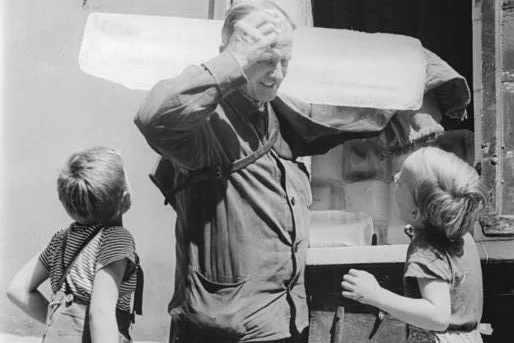
Strong teenagers once helped deliver heavy blocks of ice to homes and businesses before electric refrigeration became universal. These assistants would ride alongside delivery drivers, using ice tongs and protective shoulder pads to carry blocks weighing up to 100 pounds into customers’ homes and ice boxes. The job built impressive physical strength while teaching careful handling of a quickly-degrading product that required efficient delivery and proper storage techniques.
What happened? Home refrigeration technology rendered ice delivery obsolete, eliminating a physically demanding entry-level position that once employed many young men. The service industry has largely shifted away from heavy manual labor opportunities for teens toward retail and food service positions that require different skill sets. Modern teens rarely experience jobs that build the same level of physical capability and practical problem-solving that came from manipulating heavy ice blocks in varied delivery situations. This job represents how technological convenience has eliminated certain character-building physical challenges from youth employment.
7. Phone Booth Attendant
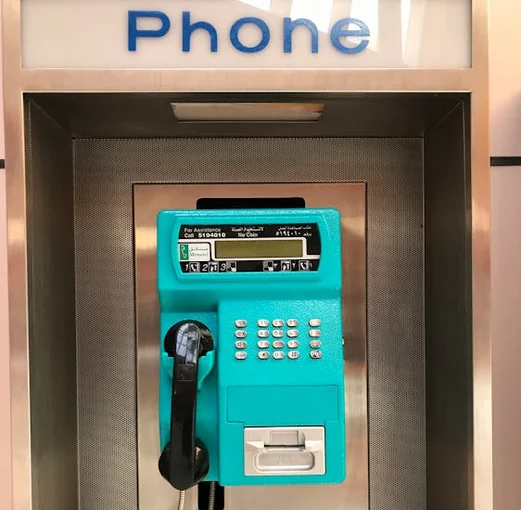
In busy urban areas, teens once maintained public phone booths, providing change, phonebooks, and sometimes even placing calls for customers. These attendants kept booths clean, reported damage, restocked directories, and often became neighborhood fixtures who knew the rhythms of their communities. The position taught money handling, directory assistance skills, and how to interact professionally with a diverse clientele from all walks of life.
What happened? Mobile phones eliminated the need for public telephone booths and their attendants, removing this entry-level position from the employment landscape. Today’s teens have likely never even seen a fully-functional phone booth, much less considered it a workplace. The disappearance of this job reflects not just technological change but a shift away from public infrastructure that created employment opportunities for young people. The community connection and public service aspects of this position have few modern equivalents in today’s teen job market.
8. Elevator Operator
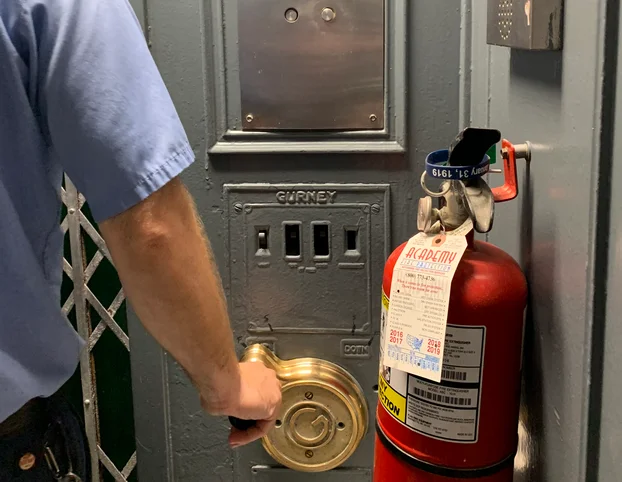
Before self-service elevators became standard, teens often operated manual elevator controls, announcing floors and ensuring passenger safety. Dressed in uniform and sometimes wearing white gloves, these young workers learned precise control of the elevator car while providing a formal welcome to building visitors. The position required perfect attention to detail, as operators needed to stop the car level with each floor, operate manual doors correctly, and maintain a strict schedule during busy periods.
What happened? Automated elevator systems eliminated the need for human operators in all but the most exclusive or historic buildings. The position, which taught teens about professional presentation and composed customer interaction, has been replaced by buttons and recorded announcements. Today’s young people rarely experience jobs that combine technical operation with formal customer service in the way elevator operation once did. This profession represents how automation has removed not just physical tasks but also roles that taught young people about professional deportment and composure under observation.
9. Gas Station Attendant

Teenaged attendants once pumped gas, checked oil, cleaned windshields, and provided directions at service stations across America. These jobs combined customer service with basic automotive knowledge, teaching young workers about car maintenance while developing sales skills for additional services. The position required developing trust with customers while efficiently handling cash transactions and providing quick service during busy periods.
What happened? Self-service pumps and changing profit models transformed gas stations from service-oriented businesses to convenience stores with minimal staffing. While teens might work inside modern gas stations as cashiers, the full-service attendant role—with its combination of customer service and practical automotive knowledge—has largely disappeared except in a few states with self-service bans. Today’s teens miss out on the practical mechanical familiarity and pride in service that came from this once-common entry point to the workforce, representing a shift from hands-on technical skills to purely transactional roles.
10. TV Repair Assistant
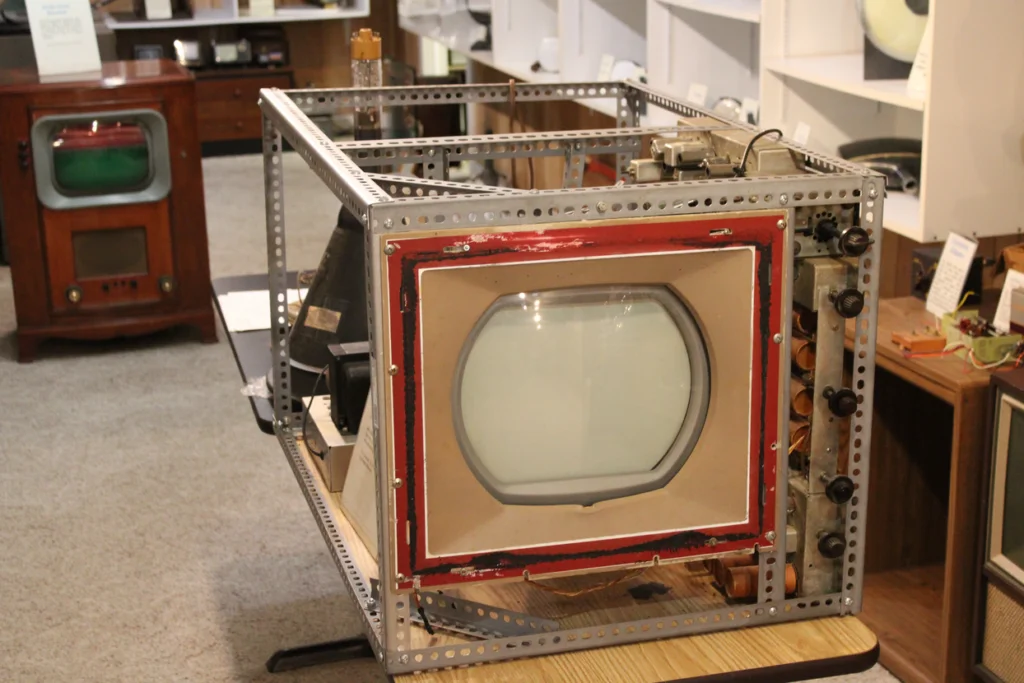
Teen assistants once helped television repair technicians by carrying tools, learning basic electronics, and eventually performing simple repairs themselves. These positions often operated as informal apprenticeships where young people gained technical knowledge while developing problem-solving skills in customers’ homes. The job provided exposure to electronics fundamentals that could lead to careers in emerging technology fields while teaching professional conduct in residential service calls.
What happened? Disposable electronics culture and miniaturized circuitry made TV repair increasingly rare, eliminating these hands-on learning opportunities. Modern electronics are designed to be replaced rather than repaired, and the few repairs still performed require specialized training and equipment not suitable for entry-level positions. Today’s technology-oriented teens might code or create digital content but rarely experience the practical electronic troubleshooting that once provided a gateway to technical careers. This shift represents the broader move from a repair culture to a replacement economy that offers fewer opportunities for young people to develop hands-on technical skills.
11. Milk Delivery Assistant
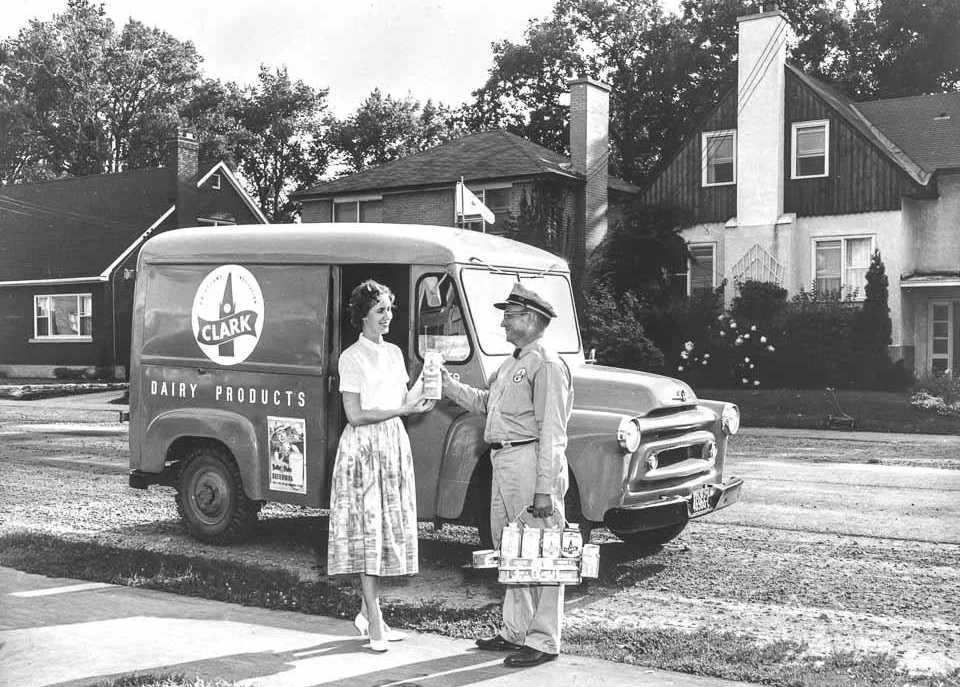
Early-rising teens once helped deliver glass bottles of fresh milk to doorsteps, learning efficient route management and developing relationships with regular customers. These assistants would ride alongside milkmen, quickly delivering bottles while collecting empties and sometimes handling customer payments or special orders. The position taught logistics planning, time management, and the importance of consistent service that customers depended upon for a daily essential.
What happened? Supermarket refrigeration, changing food shopping patterns, and centralized dairy distribution eliminated home milk delivery services in most communities. The predictable, neighborhood-based employment that once connected teens to their communities through daily service has largely disappeared from the employment landscape. While today’s “gig economy” offers delivery opportunities, these typically require vehicles and adult workers rather than providing entry-level positions for neighborhood teens. This job’s disappearance represents the shift from relationship-based local commerce to anonymous centralized retail.
12. Drive-In Theater Attendant

Teenagers once staffed America’s drive-in theaters, directing cars, hanging speakers, operating concession stands, and maintaining the grounds during and between showings. These evening and weekend positions provided flexible schedules perfect for students while teaching diverse skills from food preparation to traffic management. The social atmosphere of drive-ins made these jobs particularly appealing, combining work with a vibrant community gathering place that stood at the center of youth culture.
What happened? The decline of drive-in theaters eliminated these unique employment opportunities that combined outdoor work, customer service, and technical operation. While indoor theaters still employ teens, the multifaceted responsibilities and community atmosphere of drive-in employment created a distinctive work experience now largely lost. The drive-in attendant position represents how changing entertainment patterns have eliminated certain youth jobs that once connected teens to broader community life while teaching diverse practical skills in a single employment setting.
The disappearance of these once-common jobs reflects more than just technological advancement—it represents a fundamental shift in how young people enter the workforce and develop professional identities. Today’s teen employment landscape offers fewer opportunities for hands-on learning, community connection, and independence than previous generations enjoyed. While modern teens can gain valuable experience through current entry-level positions, many of the unique skill combinations and character-building challenges offered by these vanished jobs have no direct modern equivalents. Perhaps understanding what’s been lost can help us better appreciate the distinctive value these positions once provided in developing young workers—and inspire us to create new opportunities that combine technology with the personal responsibility, community connection, and diverse skill development that made these classic teen jobs so formative for generations past.


